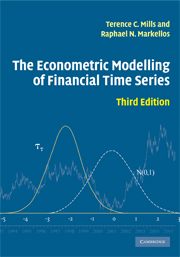Book contents
- Frontmatter
- Contents
- List of figures
- List of tables
- Preface to the third edition
- 1 Introduction
- 2 Univariate linear stochastic models: basic concepts
- 3 Univariate linear stochastic models: testing for unit roots and alternative trend specifications
- 4 Univariate linear stochastic models: further topics
- 5 Univariate non-linear stochastic models: martingales, random walks and modelling volatility
- 6 Univariate non-linear stochastic models: further models and testing procedures
- 7 Modelling return distributions
- 8 Regression techniques for non-integrated financial time series
- 9 Regression techniques for integrated financial time series
- 10 Further topics in the analysis of integrated financial time series
- Data appendix
- References
- Index
8 - Regression techniques for non-integrated financial time series
Published online by Cambridge University Press: 05 June 2012
- Frontmatter
- Contents
- List of figures
- List of tables
- Preface to the third edition
- 1 Introduction
- 2 Univariate linear stochastic models: basic concepts
- 3 Univariate linear stochastic models: testing for unit roots and alternative trend specifications
- 4 Univariate linear stochastic models: further topics
- 5 Univariate non-linear stochastic models: martingales, random walks and modelling volatility
- 6 Univariate non-linear stochastic models: further models and testing procedures
- 7 Modelling return distributions
- 8 Regression techniques for non-integrated financial time series
- 9 Regression techniques for integrated financial time series
- 10 Further topics in the analysis of integrated financial time series
- Data appendix
- References
- Index
Summary
The analysis of the general linear regression model forms the basis of every standard econometrics text and we see no need to repeat such a development here. Models relating to financial time series, however, often cannot be analysed within the basic framework of ordinary least squares regression, or even its extensions incorporating generalised least squares or instrumental variables techniques. This chapter therefore develops a general theory of regression, based on the original work of Hansen (1982), White (1984) and White and Domowitz (1984), that builds upon the univariate time series techniques of the previous chapters and is applicable to many, but by no means all, of the regression problems that arise in the analysis of the relationships between financial time series.
Section 8.1 thus sets out the basic dynamic linear regression model, while section 8.1 incorporates ARCH error effects into the framework. Misspecification testing is the topic of section 8.3, and section 8.4 discusses robust estimation techniques and generalised method of moments (GMM) estimation, which may be used when the standard assumptions of regression are found to be invalid. The multivariate linear regression model is briefly introduced in section 8.5. This paves the way for more general multivariate regression techniques, and the remaining sections of the chapter deal with vector autoregressions and its various extensions, including a discussion of the concepts of exogeneity and causality.
- Type
- Chapter
- Information
- The Econometric Modelling of Financial Time Series , pp. 274 - 328Publisher: Cambridge University PressPrint publication year: 2008



